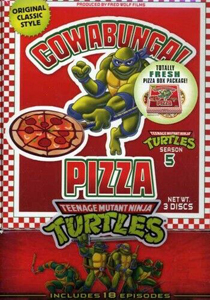“Teenage Mutant Ninja Turtles’ ” writers mix things up a bit by trying for a little character development and even some continuity in the back half of Season 5 (1991, CBS). This batch of 11 episodes includes a candidate for one of the elite “Turtles” episodes, “Donatello’s Duplicate” (episode 14, written by Carole and Jack Mendelsohn).
Donnie brazenly creates a clone of himself, and Barry Gordon shows off his voice-acting chops, making Clone Don amusingly arrogant. Since this is “TMNT,” there’s also a smart-rat version of Donatello that gets forgotten in the script. With the Rat King and Pinky McFingers also stepping in, this is fast-paced, ridiculous “TMNT” at its best.
Sequels, in a flash
Another strong entry, “Leonardo, the Renaissance Turtle” (19, Dennis O’Flaherty), accidentally reveals the show’s open secret: that Donnie is by far the most valuable Turtle when it comes to saving the day. Leo must overcome robocop menace LEX on his own, since Don is busy repairing a sewer sensor and Mikey and Raph split to visit the Punk Frogs in Florida the very second they’re no longer needed to fight crime.

“Teenage Mutant Ninja Turtles” Season 5, episodes 12-22 (1991)
CBS
Episodes: “Raphael Versus the Volcano” (12), “Landlord of the Flies” (13), “Donatello’s Duplicate” (14), “The Ice Creature Cometh” (15), “Leonardo Cuts Loose” (16), “Pirate Radio” (17), “Raphael, Turtle of a Thousand Faces” (18), “Leonardo, the Renaissance Turtle” (19), “Zach and the Alien Invaders” (20), “Welcome Back, Polarisoids” (21), “Michaelangelo, the Sacred Turtle” (22)
Producer: Fred Wolf
Writers: Carole Mendelsohn (12, 14), Gordon Bressack (13), Jack Mendelsohn (14), David Wise (15, 16), Misty Taggart (17, 21), Dennis O’Flaherty (18, 19, 22), Francis Moss and Ted Pedersen (20)
Although Leo picks up traits of Mikey (using the Cheapskate) and Raph (making a quip), what’s most important is that he figures out the tech side of things. He also shows delegation skills in recruiting help from April, who then suggests they fire up REX-1, from Season 2’s “New York’s Shiniest.”
It’s a stretch to say the writers suddenly care about continuity, but at least O’Flaherty recently rewatched “New York’s Shiniest,” and Misty Taggart rewatched Season 3’s “Camera Bugged” in preparation for “Welcome Back, Polarisoids” (21). Shredder even recalls the horror of being trapped in the alien tourists’ camera.
While the Polarisoids – and the jokey music cue that accompanies them – are best enjoyed in very small doses, Krang’s reversal of the camera technology (spewing monsters into New York City) is refreshingly forward-thinking. A similar plot happened in Season 4’s “Rondo in New York,” which goes unreferenced here, but I’ll take what I can get.

Casey at the bat again
“Rondo” parodied the musclebound action heroes of 1980s cinema, and so does “Leonardo Cuts Loose” (16, David Wise). The Turtles are awkwardly roped into a thinly veiled, overly cautious parable about steroid users as three of them are happy to pump iron on their gifted workout equipment whereas Leo believes they should focus on traditional ninja training.
The highlight is that Casey Jones finally appears in his third episode. His anti-lawbreaker obsession is flatly familiar, and his infiltration of a gym isn’t as funny as his infiltration of office cubicles in Season 3’s “Corporate Raiders from Dimension X.”
While it’s refreshing that “Polarisoids” and “Leonardo, the Renaissance Turtle” look to the shows’ own past for sequel ideas, and that the writers remember Casey is in the cast, this batch of course also features many pop-culture riffs.
Masters of disguise
“Raphael Versus the Volcano” (12, Carole Mendelsohn) is a straight take on the movie “Joe Versus the Volcano” but it enlarges the world a tad as Raph goes to a volcanic island – although granted it seems to be right off the coast of New Jersey.
“Raphael, Turtle of a Thousand Faces” (18) – a play on the film “Man of a Thousand Faces” — is stronger as O’Flaherty digs into Raphael’s status as merely the group’s quipster. In Season 4’s “Raphael Knocks ’Em Dead,” Raph was fine with who he is, but now he feels he should contribute more to the group and tries to become a detective who is a master of disguise.
The Turtles’ trench coat disguises are staples by now, but sometimes they also use their sailor disguises. (In both cases, we can clearly see they are giant turtles, and besides, they don’t need to hide from the populace anyway – but I’m used to this internal logic oddity by now.)
A miscommunication – likely because multiple studios worked on the episode – leads to a funny error in “Michaelangelo, the Sacred Turtle” (22, O’Flaherty). Mikey is in the sailor outfit before a commercial break and in the trench coat disguise after. It’s amusing, as are the worshipful “cowabungas” from the Egyptians who bow before Mikey, thinking he is the reincarnation of King Amun Turt-El.
Despite his ridiculous situation, Mikey is the go-with-the-flow Turtle. “Pirate Radio” (17, Taggart) could be seen as a Michaelangelo episode, as his brothers kick him out of the lair for blasting rock music too loud. Krang’s and Shredder’s (temporarily successful) attempt to turn people into zombies via the airwaves would’ve made for a more fun episode if something other than generic music could’ve been used.
A screwy introduction
Contrasting the character growth for Don, Leo and Raph – and the reminder that Mikey is who he is — “Zach and the Alien Invaders” (20, Francis Moss and Ted Pedersen) is at the other end of the spectrum. As I noted in my last review, Playmates had apparently asked the cartoon to incorporate action figures into Season 5, and the Mondo Gecko, Mutagen Man and Muckman debuts were respectable. This Wingnut & Screwloose episode … not so much.
The alien bat and mosquito had gotten excellent characterization in the Archie comic, starting with 1990’s Issue 8. They are tragically the last of their symbiotic species thanks to Krang destroying their homeworld. Here, they are generic aliens brainwashing kids (including Fifth Turtle Zach, wrongly put there by his parents) at a military school.
I would request a mind-wipe myself, except that “Zach and the Alien Invaders” is forgettable enough on its own (actually a saving grace, as is the fact that this is the only appearance of the toon’s bland take on W&S). A slight tip of the cap must go to the daringness of criticizing the military in a kids’ show, making this a good companion piece to “Renaissance Turtle’s” parody of anti-crime initiatives.
Enemies big and small
The two other episodes are big, action-oriented romps that would be more fun if “TMNT” had better animation (“Pirate Radio” and “Polarisoids” are also of this type). “Landlord of the Flies” (13, Gordon Bressack) finds Baxter Stockman using the Rat King’s city-takeover plot, but with flies.
How he can control swarms of flies goes unexplained (although perhaps his status as a giant fly is explanation enough), as does his return from an alternate dimension and the fate his computer friend Z from Season 4’s “Son of Return of the Fly II.”
To say the garbage-and-fly infestation is a commentary on the 1977 NYC sanitation workers’ strike is likely to give the show too much credit. It is interesting, though, to see the Turtles’ version of NYC includes a retractable-roof ballpark. Just two years before this, the first functioning retractable roof park opened in MLB, although it was in Toronto.
“The Ice Creature Cometh” (15, Wise) is cute for how Bebop loves his pet giant snow beast, Frosty. When Frosty melts and freezes the Technodrome more solidly than ever in Arctic ice, it’s pretty much a repeat of the battle machine getting further encased in lava in Season 4’s “Poor Little Rich Turtle.” Krang even says “Oh no, no-no-no” in the same way.
This show loves its go-to gags, and they’re sometimes worth a smirk, sometimes worth an eye-roll. This batch’s brief attempts at character development are eye-opening, though, giving “Teenage Mutant Ninja Turtles” a minor uptick at a time when the quality level had plateaued.

